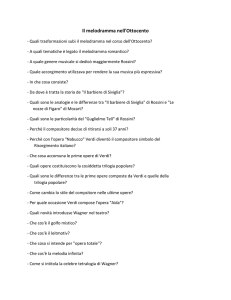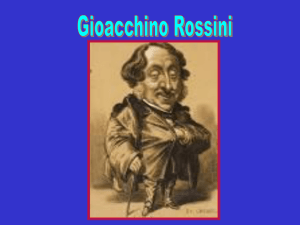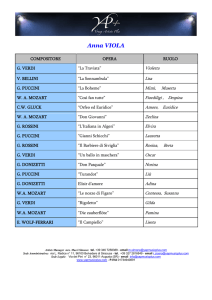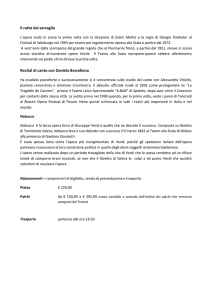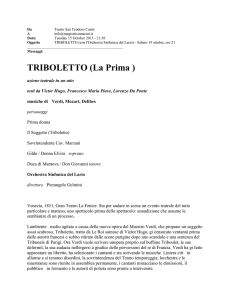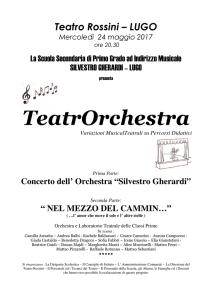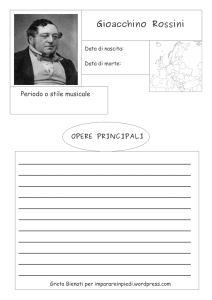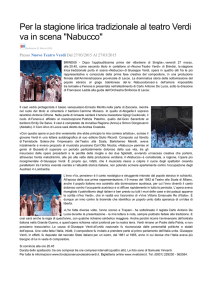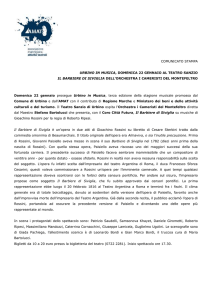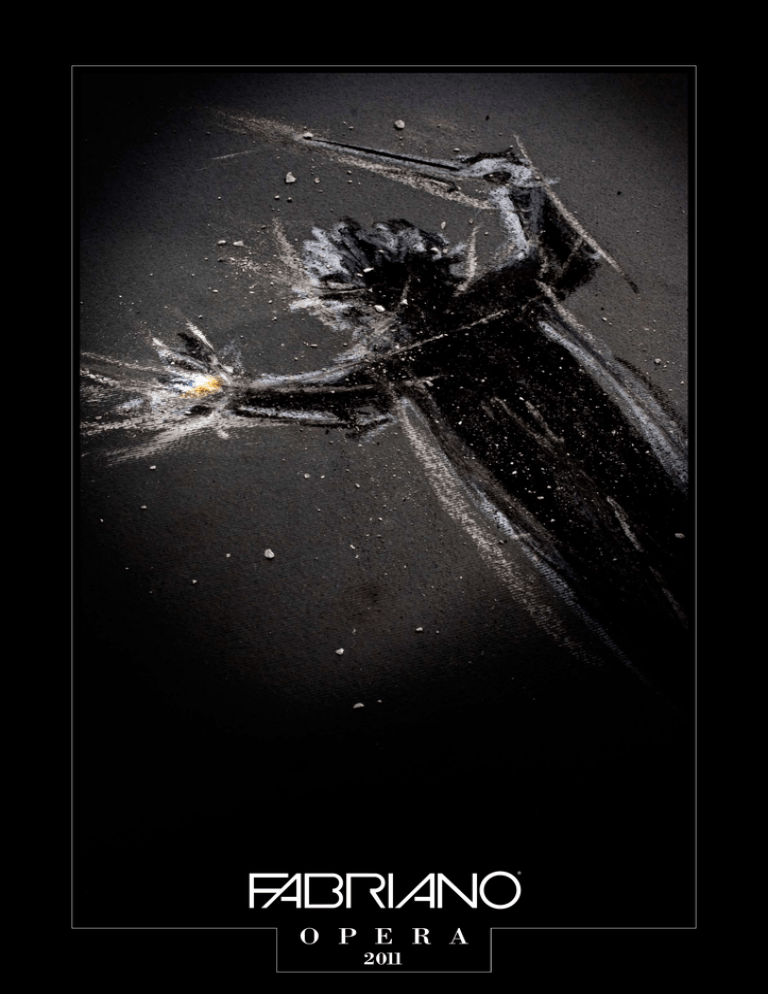
Gioachino Rossini
Il barbiere di Siviglia
O P ERA
2011
Fabriano e l’Opera:
da secoli eccellenze di creatività italiana, momenti sottolineati
da attimi di luce, da irripetibili armonie.
Fabriano and Opera:
for centuries, sources of excellence in Italian creativity.
Flashes of brilliance and unparalleled harmonies.
O P E R A
2011
Ottoni, legni, archi come pennelli, pastelli, pennini:
tracce nella memoria, segni nel futuro.
Brass, woodwind and strings, like brushes, pastels and pen-nibs:
trace the past and write the future.
Tiepolo (tenore / tenor)
Rosaspina (soprano / soprano)
Esportazione (violini / violins)
Artistico (viole / violas)
Fabriano 5 (violoncelli / ‘cellos)
Pittura (contrabbassi / double basses)
Watercolour (arpa / harp)
Tela (flauti traversi/ flutes)
Roma (ottavino / piccolo)
Accademia (oboi / oboes)
Tiziano (corno inglese / cor anglais)
Murillo (clarinetti / clarinets)
ElleErre (fagotti / bassoons)
Ingres (controfagotto / double bassoon)
Venezia Book (corni / horns)
Bouquet (trombe / trumpets)
Murillo (tromboni / trombones)
Rusticus (bombardino / euphonium)
Fabria (tuba / tuba)
Compositore / Composer
Cartiere Miliani Fabriano
Direttore d’orchestra / Conductor
Capolinea.it
Libretto / Libretto
Tecnostampa, Ostra Vetere
Grifo (pianoforte / pianoforte)
Palatina (celesta / celeste)
Bioprima (timpani / tympani)
Secolo XIII (rullante / snare drum)
Florentia (grancassa / bass drum)
Minerva (piatti / cymbals)
Medioevalis (triangolo / triangle)
Gioachino Rossini
design: capolinea.it
Il barbiere di Siviglia
O P ERA
2011
SA
GENNAIO
DO
01 02
SA
LU
MA ME
GI
VE
SA
DO
03 04 05 06 07 08 09
SU MO TU
WE
TH
FR
SA
LU
MA ME
GI
VE
SA
DO
10 11 12 13 14 15 16
SU MO TU
WE
TH
FR
SA
LU
MA ME
GI
VE
SA
DO
17 18 19 20 21 22 23
SU MO TU
WE
TH
FR
SA
LU
MA
ME
GI
VE
SA
DO
24 25 26 27 28 29 30
SU MO TU
WE
TH
FR
SA
LU
31
SU MO
JANUARY
Giuseppe Verdi
design: capolinea.it
Aida
O P ERA
2011
MA ME
FEBBRAIO
GI
VE
SA
DO
01 02 03 04 05 06
TU
WE
TH
FR
SA
LU
MA ME
GI
VE
SA
DO
07 08 09 10 11 12 13
SU MO TU
WE
TH
FR
SA
LU
MA ME
GI
VE
SA
DO
14 15 16 17 18 19 20
SU MO TU
WE
TH
FR
SA
LU
MA
ME
GI
VE
SA
DO
21 22 23 24 25 26 27
SU MO TU
WE
TH
FR
SA
LU
28
SU MO
FEBRUARY
Vincenzo Bellini
design: capolinea.it
Norma
O P ERA
2011
MA ME
MARZO
GI
VE
SA
DO
01 02 03 04 05 06
TU
WE
TH
FR
SA
LU
MA ME
GI
VE
SA
DO
07 08 09 10 11 12 13
SU MO TU
WE
TH
FR
SA
LU
MA ME
GI
VE
SA
DO
14 15 16 17 18 19 20
SU MO TU
WE
TH
FR
SA
LU
MA
ME
GI
VE
SA
DO
21 22 23 24 25 26 27
SU MO TU
WE
TH
FR
SA
LU MA
ME
GI
28 29 30 31
SU MO TU
WE
TH
MARCH
Ruggero Leoncavallo
design: capolinea.it
Pagliacci
O P ERA
2011
VE
APRILE
SA
DO
01 02 03
FR
SA
LU
MA ME
GI
VE
SA
DO
04 05 06 07 08 09 10
SU MO TU
WE
TH
FR
SA
LU
MA ME
GI
VE
SA
DO
11 12 13 14 15 16 17
SU MO TU
WE
TH
FR
SA
LU
MA
ME
GI
VE
SA
DO
18 19 20 21 22 23 24
SU MO TU
WE
TH
FR
SA
LU MA
ME
GI
VE
SA
25 26 27 28 29 30
SU MO TU
WE
TH
FR
SA
APRIL
Giacomo Puccini
design: capolinea.it
Turandot
O P ERA
2011
DO
MAGGIO
01
LU
MA ME
GI
VE
SA
DO
02 03 04 05 06 07 08
SU MO TU
WE
TH
FR
SA
LU
MA ME
GI
VE
SA
DO
09 10 11 12 13 14 15
SU MO TU
WE
TH
FR
SA
LU
MA ME
GI
VE
SA
DO
16 17 18 19 20 21 22
SU MO TU
WE
TH
FR
SA
LU
MA
ME
GI
VE
SA
DO
23 24 25 26 27 28 29
SU MO TU
WE
TH
FR
SA
LU
MA
30 31
SU MO TU
MAY
Giuseppe Verdi
design: capolinea.it
Otello
O P ERA
2011
ME
GIUGNO
GI
VE
SA
DO
01 02 03 04 05
WE
TH
FR
SA
LU
MA ME
GI
VE
SA
DO
06 07 08 09 10 11 12
SU MO TU
WE
TH
FR
SA
LU
MA ME
GI
VE
SA
DO
13 14 15 16 17 18 19
SU MO TU
WE
TH
FR
SA
LU
MA
ME
GI
VE
SA
DO
20 21 22 23 24 25 26
SU MO TU
WE
TH
FR
SA
LU
MA ME
GI
27 28 29 30
SU MO TU
WE
TH
JUNE
Gioachino Rossini
design: capolinea.it
La gazza ladra
O P ERA
2011
VE
LUGLIO
SA
DO
01 02 03
FR
SA
LU
MA ME
GI
VE
SA
DO
04 05 06 07 08 09 10
SU MO TU
WE
TH
FR
SA
LU
MA ME
GI
VE
SA
DO
11 12 13 14 15 16 17
SU MO TU
WE
TH
FR
SA
LU
MA
ME
GI
VE
SA
DO
18 19 20 21 22 23 24
SU MO TU
WE
TH
FR
SA
LU
MA ME
GI
VE
SA
DO
25 26 27 28 29 30 31
SU MO TU
WE
TH
FR
SA
SU
JULY
Giovan Battista Pergolesi
design: capolinea.it
La serva padrona
O P ERA
2011
LU
AGOSTO
MA ME
GI
VE
SA
DO
01 02 03 04 05 06 07
MO TU
WE
TH
FR
SA
LU
MA ME
GI
VE
SA
DO
08 09 10 11 12 13 14
SU MO TU
WE
TH
FR
SA
LU
MA ME
GI
VE
SA
DO
15 16 17 18 19 20 21
SU MO TU
WE
TH
FR
SA
LU
MA
ME
GI
VE
SA
DO
22 23 24 25 26 27 28
SU MO TU
WE
TH
FR
SA
LU MA
ME
29 30 31
SU MO TU
WE
AUGUST
Pietro Mascagni
design: capolinea.it
Cavalleria rusticana
O P ERA
2011
GI
SETTEMBRE
VE
SA
DO
01 02 03 04
TH
FR
SA
LU
MA ME
GI
VE
SA
DO
05 06 07 08 09 10 11
SU MO TU
WE
TH
FR
SA
LU
MA ME
GI
VE
SA
DO
12 13 14 15 16 17 18
SU MO TU
WE
TH
FR
SA
LU
MA
ME
GI
VE
SA
DO
19 20 21 22 23 24 25
SU MO TU
WE
TH
FR
SA
LU
MA ME
GI
VE
26 27 28 29 30
SU MO TU
WE
TH
FR
SEPTEMBER
Gaetano Donizetti
design: capolinea.it
L’elisir d’amore
O P ERA
2011
SA
OTTOBRE
DO
01 02
SA
LU
MA ME
GI
VE
SA
DO
03 04 05 06 07 08 09
SU MO TU
WE
TH
FR
SA
LU
MA ME
GI
VE
SA
DO
10 11 12 13 14 15 16
SU MO TU
WE
TH
FR
SA
LU
MA ME
GI
VE
SA
DO
17 18 19 20 21 22 23
SU MO TU
WE
TH
FR
SA
LU
MA
ME
GI
VE
SA
DO
24 25 26 27 28 29 30
SU MO TU
WE
TH
FR
SA
LU
31
SU MO
OCTOBER
Giacomo Puccini
design: capolinea.it
Tosca
O P ERA
2011
MA ME
NOVEMBRE
GI
VE
SA
DO
01 02 03 04 05 06
TU
WE
TH
FR
SA
LU
MA ME
GI
VE
SA
DO
07 08 09 10 11 12 13
SU MO TU
WE
TH
FR
SA
LU
MA ME
GI
VE
SA
DO
14 15 16 17 18 19 20
SU MO TU
WE
TH
FR
SA
LU
MA
ME
GI
VE
SA
DO
21 22 23 24 25 26 27
SU MO TU
WE
TH
FR
SA
LU MA
ME
28 29 30
SU MO TU
WE
NOVEMBER
Giuseppe Verdi
design: capolinea.it
La traviata
O P ERA
2011
GI
DICEMBRE
VE
SA
DO
01 02 03 04
TH
FR
SA
LU
MA ME
GI
VE
SA
DO
05 06 07 08 09 10 11
SU MO TU
WE
TH
FR
SA
LU
MA ME
GI
VE
SA
DO
12 13 14 15 16 17 18
SU MO TU
WE
TH
FR
SA
LU
MA
ME
GI
VE
SA
DO
19 20 21 22 23 24 25
SU MO TU
WE
TH
FR
SA
LU MA
ME
GI
VE
SA
26 27 28 29 30 31
SU MO TU
WE
TH
FR
SA
DECEMBER
Gioachino Rossini
Il barbiere di Siviglia
Giuseppe Verdi
Aida
Debuttata il 20 febbraio 1816, la prima si rivelò un grande insuccesso
e, costellata da una serie di incidenti sulla scena, terminò tra i fischi dei
presenti. Pettegolezzi dell’epoca, attribuiscono il cattivo esito alla forte
contrarietà degli impresari di un teatro concorrente (Teatro Valle) e alla
ancor più strenua opposizione dei sostenitori di Paisiello, compositore
contemporaneo a Rossini che aveva già messo in scena l’opera. Infatti,
il solo annuncio che Rossini stava preparando una nuova versione del
Barbiere di Siviglia aveva immediatamente suscitato innumerevoli
polemiche, anche in considerazione del fatto che all’epoca Paisiello era
ancora vivo. L’insuccesso della prima, però, fu immediatamente riscattato
dal successo delle repliche e l’opera di Rossini finì ben presto per
oscurare la precedente versione di Paisiello.
Composta su commissione del viceré d’Egitto, Aida rappresenta la più
classica delle opere verdiane. Dopo alterne vicende e non poche difficoltà,
la prima andò in scena al Cairo il 24 dicembre 1871 accompagnata dagli
applausi del viceré che fu talmente soddisfatto dell’opera da premiare
Verdi con il titolo di Commendatore dell’Ordine Ottomano. Appena
due mesi dopo, Aida andò in scena alla Scala di Milano con un cast
d’eccezione che determinò inequivocabilmente il successo nazionale e
internazionale dell’opera, consacrandola tra gli assoluti capolavori della
lirica verdiana. Ad oggi il luogo ideale per eseguire quest’opera rimane
l’Arena di Verona che, grazie ai suoi ampi spazi, consente di creare
meravigliose scenografie dell’Antico Egitto.
Barber’s opening performance on 20th February 1816 was a huge failure;
plagued by a series of on-stage accidents, it closed to jeers and whistles
from the audience. Rumours at the time attributed its poor reception to
strong opposition from the impresarios of a rival theatre, the Teatro Valle,
and even more formidable opposition from supporters of one of Rossini’s
contemporaries, Paisiello, who had already staged the opera.
In fact, the mere announcement that Rossini was preparing a new version
of The Barber of Seville had immediately provoked intense debate, not
least because Paisiello was still alive at the time. However, its initial
failure was almost immediately forgotten due to its success on subsequent
performances, and Rossini’s version soon eclipsed Paisiello’s earlier
production.
Composed on commission of the viceroy of Egypt, Aida is Verdi’s most
classic opera. After several ups and downs, it finally made its debut in
Cairo on 24th December 1871 and was met with rapturous applause from
the viceroy. So pleased was the viceroy with the opera, that he rewarded
Verdi with the title, Commendatore of the Ottoman Order. Just two
months later, Aida was performed by an exceptional cast at La Scala in
Milan unequivocally sealing its national and international success and
establishing it as one of Verdi’s finest lyrical masterpieces. To this day,
the Arena di Verona remains the ideal place to perform the opera; its
wide open spaces allow the wondrous scenes from Ancient Egypt to be
beautifully recreated.
Vincenzo Bellini
Norma
Ruggero Leoncavallo
Pagliacci
Composta in tempi brevissimi, in meno di tre mesi, la prima debuttò al
Teatro alla Scala di Milano il 26 dicembre 1832. Destinata a diventare
una delle opere più popolari del compositore, quella sera Bellini si trovò
ad affrontare un clamoroso insuccesso causato dalla tensione psicologica
dei membri del cast e soprattutto dalla presenza di un folto gruppo di
oppositori del compositore e della primadonna, la soprano Giuditta Pasta.
L’opera, incentrata sulla protagonista, divenne il cavallo di battaglia
di alcune grandi soprano del passato, tra cui Maria Callas. Poche però
furono le occasioni in cui l’opera fu messa in scena. Infatti, la complessità
del personaggio e ancor più la versatilità richiesta alle capacità vocali
e liriche ne hanno spesso scoraggiato la rappresentazione tanto che
ancora oggi il ruolo di Norma viene definito come uno dei più impervi da
interpretare.
Messa in scena per la prima volta nel 1892 al Teatro dal Verme di Milano,
l’opera rappresenta una decisa svolta per il compositore napoletano. Per
la trama Leoncavallo si ispirò a un delitto realmente accaduto durante
la sua infanzia e che vide il padre, magistrato, istruire il processo per la
condanna di un uxoricida. La rappresentazione ebbe immediatamente
successo e ancora oggi rimane una delle opere più popolari e conosciute.
Sicuramente l’aria più famosa è la celeberrima “Recitar! Vesti la giubba”,
spesso chiamata “Ridi, Pagliaccio” che nell’interpretazione di Caruso
vendette addirittura un milione di copie. Pagliacci va ricordata anche per
due importanti primati: nel 1907 fu la prima opera ad essere registrata e
nel 1931 fu la prima opera completa ad essere filmata con traccia sonora.
Composed extremely quickly, in under three months, Norma debuted at
La Scala in Milan on 26th December 1832. Although it would become
one of Bellini’s most popular operas, that evening, he was faced with a
resounding failure. Its lack of success was in part due to the psychological
stress afflicting some of its cast members but was mostly provoked by
the presence in the audience of a large number of opponents of the
composer and his leading lady, the soprano, Giuditta Pasta. The opera,
which centres on the title character, became the pièce de résistance role
for some of history’s greatest sopranos, including Maria Callas. Sadly,
the opera was only staged a few times as the complexity of character and
required versatility in operatic and vocal ability often discouraged its
performance. Even today, the role of Norma is considered one of opera’s
most challenging performances.
Staged for the first time in 1892 at Milan’s Teatro dal Verme, the opera
represents a crucial turning point for the Neapolitan composer.
Leoncavallo’s storyline was inspired by a real-life crime that took place
when he was a child and his father, a judge, presided over the trial for
the conviction of a wife murderer. It was an instant success, and to this
day remains one of the world’s most popular and well-known operas. The
most famous aria has to be the celebrated “Recitar! Vesti la giubba”,
often called “Ridi, Pagliaccio”. Caruso’s recording of the aria sold over a
million copies. Pagliacci should be remembered for two important firsts:
in 1907, it was the first opera to be recorded and in 1931, it was the first
complete opera to be filmed with sound.
Giacomo Puccini
Turandot
Giuseppe Verdi
Otello
L’incompiutezza dell’opera accende tutt’oggi intensi dibattiti fra gli
studiosi: perché il compositore non ha terminato il suo lavoro? quale
significato voleva attribuire al finale? Accanto a chi sostiene che
Turandot rimase incompiuta a causa dell’inesorabile progredire del male
che affliggeva l’autore, c’è chi sostiene che Puccini non sia riuscito a
terminare l’opera a causa dell’intima impossibilità di interpretare fino
alla fine quel trionfo d’amore che all’inizio lo aveva tanto appassionato.
L’ostacolo al completamento dell’opera, dunque, risiederebbe proprio
nella sua protagonista e nella mutevolezza, o meglio nell’evoluzione, della
sua personalità: da principessa fredda e glaciale, incapace di amare e
compiaciuta nel ferire i propri pretendenti a donna innamorata.
Penultimo lavoro di Giuseppe Verdi, Otello rappresenta un ritorno
del compositore ai temi shakespeariani già affrontati nel Macbeth.
In collaborazione con Boito, che scrisse il libretto, Verdi decise di
modificare lo svolgimento dei fatti rispetto all’opera originale per rendere
la drammaturgia più serrata possibile. La stesura fu comunque più lunga
e difficoltosa del previsto. Verdi, infatti, oppresso dal suo forte senso di
responsabilità nei confronti di Shakespeare e dal peso della sua popolarità
e reputazione, rifiutò più volte di fissare la data della prima prolungando
notevolmente il periodo delle prove. L’opera andò finalmente in scena il
5 febbraio 1887 al Teatro Scala di Milano attirando su di sé l’attenzione
del pubblico nazionale e internazionale tanto che per l’occasione tutti i
giornali europei inviarono un proprio corrispondente.
This unfinished opera still provokes intense debate among scholars to
this day: why did the composer not finish the work? What significance
did he want to give to the ending? Next to those who claim that Turandot
was never finished because of the unrelenting advance of the illness that
afflicted Puccini, there are others who claim he was unable to complete
the opera because of his personal inability to interpret the triumph of love
in the end, something which had so thrilled him at first. The obstacle to
its completion lay in its central character and in the mutability, or rather
the evolution, of her character: from a cruel and icy princess, incapable of
love and complacent to hurting her suitors, into a woman passionately in
love.
O P ERA
2011
Giuseppe Verdi’s penultimate work, Otello, represents a return by the
composer to Shakespearean themes, already addressed in his work
Macbeth. In collaboration with Boito, who wrote the libretto, Verdi
decided to modify the plot from the original opera to make the dramaturgy
more concise. But the draft was still longer and more onerous than he
had intended. In fact, overwhelmed by his strong sense of responsibility
towards Shakespeare and the weight of his popularity and reputation,
Verdi refused to set the date for the opening performance several times,
considerably prolonging the rehearsal period. The opera was finally staged
on 5th February 1887 at La Scala in Milan. The event generated so much
national and international attention that newspapers from all across
Europe sent correspondents to cover the occasion.
Gioachino Rossini
La gazza ladra
Giovan Battista Pergolesi
La serva padrona
Commissionata dal Teatro alla Scala di Milano intorno al 1817 per il
rientro di Rossini in Italia, l’opera prende ispirazione da un soggetto tratto
dal teatro francese. Le vicende, in bilico fra il buffo e il tragico, rispettano
i personaggi e i luoghi tipici del genere semiserio. Tutta la narrazione
ruota attorno al furto di un cucchiaio, motivo scatenante di una serie
di tristi vicende che alla fine, così come prevede il copione del genere
buffo, si concludono con un lieto fine. Un finale previsto e atteso, che
però trasmette un senso di felicità nonostante l’intreccio piuttosto tragico
nel quale Rossini coinvolge lo spettatore grazie a una maestosa sinfonia
che mantiene un registro sempre alto. L’opera, reputata sin dall’epoca
un grande successo, ebbe enorme popolarità fino agli ultimi anni ‘20
dell’Ottocento, come dimostra l’alto numero di libretti e adattamenti.
Il 28 agosto 1733 al Teatro San Bartolomeo di Napoli il 23enne
Giambattista Pergolesi debuttò con il suo melodramma serio Il prigionier
superbo e, seguendo le usanze dell’epoca, presentò anche La serva
padrona, una storia divisa in due intermezzi comici che servivano a
intrattenere il pubblico nelle pause tra gli atti dell’opera. Il fragoroso e
indiscusso successo che questa rapida ma ricca commedia riportò nelle
sale napoletane rivelò subito come lo stile pungente e ironico fosse
apprezzatissimo dal pubblico dell’epoca. Pergolesi, forse senza saperlo,
aveva così creato un nuovo modello di comicità, destinata a rimanere
immortale e ad essere indicata come la vera nascita dell’opera comica:
un’opera alla quale faranno riferimento i maestri della seconda metà del
‘700 e che culminerà nei grandi lavori rossiniani.
Commissioned by Milan’s La Scala theatre around the year 1817 for
Rossini’s return to Italy, the opera takes its inspiration from French
theatre. The plot, poised between the comic and the tragic, is in keeping
with the places and characters typical of the semiserio genre. The entire
story revolves around the theft of a spoon which triggers off a series
of unhappy events that eventually culminate in a happy ending, as is
expected of the opera buffa. Despite the rather tragic plot, the predictable
happy ending conveys a sense of joy and happiness and Rossini draws
his audience into the story through a magnificent symphony played in the
upper register. The opera, which was deemed a great success, remained
enormously popular until the late 1820s, as highlighted by the large
number of libretti and adaptations that followed.
On 28th August 1733, at the Teatro San Bartolomeo in Naples, the 23
year old, Giambattista Pergolesi, debuted his melodramma serio, Il
prigionier superbo. As was the custom of the day, he also presented, La
serva padrona; a tale divided into two comic interludes to entertain the
audience during the intervals of the three-act opera. The resounding
and undisputed success that this quick but rich comedy received in the
Neapolitan theatres unexpectedly revealed that audiences appreciated
this ironic and scathing style. Pergolesi, perhaps unknowingly, had thus
created a new type of comedy, destined to go down in history and be
referred to as the true birth of comic opera: a work to which the great
masters of the second half of the 1700s would make reference and which
would culminate in Rossini’s great works.
Pietro Mascagni
Cavalleria rusticana
Gaetano Donizetti
L’elisir d’amore
La prima della Cavalleria rusticana, avvenuta il 17 maggio 1890 al
Teatro Costanzi di Roma, segnò una data storica. Infatti, il suo trionfo
dettò la nascita al Verismo della cosiddetta “Giovane scuola italiana”
dando dimostrazione che la musica italiana conservava ancora un grande
potenziale creativo che andava oltre il culmine delle composizioni di
Verdi. La prima dell’opera ottenne un successo formidabile: Mascagni
venne richiamato sul palco dagli applausi del pubblico ben 4 volte e in
quello stesso anno, in seguito al tutto esaurito delle repliche al Teatro
Costanzi, la rappresentazione fu messa in scena in tutta Italia, oltre che a
Berlino, Budapest e Londra. Ancora oggi l’opera di Mascagni è ispirazione
di importanti artisti: da Cavalleria rusticana è tratta parte della colonna
sonora del terzo capitolo de Il Padrino, mentre l’intermezzo di Cavalleria
rusticana e il notturno di Silvano sono stati ripresi da Martin Scorsese
come colonna sonora del film Toro Scatenato.
L’Elisir andò in scena per la prima volta il 12 maggio 1832 al Teatro
della Cannobiana di Milano, in sostituzione di un’opera che non era
stata preparata in tempo da un altro autore. Per consegnare il suo lavoro,
Donizetti ebbe a disposizione solo quattordici giorni, sette dei quali
furono dedicati all’adattamento del testo. La pressione e il poco tempo a
disposizione non inquinarono il risultato del lavoro che infatti divenne uno
dei più alti esempi di opera comica ottocentesca. Fin dal suo apparire,
L’Elisir ebbe un enorme successo, testimoniato anche dalle trentadue
repliche consecutive. A suscitare l’entusiasmo degli appassionati di lirica
fu soprattutto la tipica melodia donizzettiana che, anche in questo caso,
accompagna motivi piacevoli sottolineando la vena buffa del compositore
bergamasco, capace di trasformare con agilità e inventiva la risata in
sorriso, anche se talvolta velato di malinconia.
Cavalleria rusticana’s opening performance on 17th May 1890 at Rome’s
Teatro Costanzi marked an historic event. Indeed, its triumph gave birth
to the Verismo genre of the so-called “Young Italian School” and showed
that Italian music still had huge creative potential that went beyond the
peak of Verdi’s compositions. The premiere was a tremendous success:
Mascagni was called back onto stage four times by the audience and
in the same year, following its sell-out run at the Teatro Costanzi, the
opera was performed throughout Italy, as well as in Berlin, Budapest and
London. Even today, Mascagni’s work has inspired other important artists:
part of the soundtrack for The Godfather: Part III is taken from Cavalleria
rusticana, while the intermezzo from Cavalleria rusticana and the nocturne
from Silvano both feature on the soundtrack for Martin Scorsese’s film,
Raging Bull.
The Elixir was performed for the first time on 12th May 1832 at Milan’s
Teatro della Cannobiana. It took the place of another opera by a different
writer which was not completed in time. Donizetti had just fourteen days
to deliver his work, seven of which were spent adapting the text.
The pressure and the short time available to him did not to spoil the result
however and it went on to become one of the finest examples of nineteenth
century comic opera. From its first performance, Elixir was an enormous
success, proven by its run of thirty-two consecutive performances. What
generated enthusiasm most of all among opera fans was the typical
Donizettian melody. In this case it is accompanied by enjoyable tunes
that highlight the comic streak in the composer from Bergamo, who,
effortlessly and skilfully, can turn a laugh into a smile, even if sometimes
veiled in melancholy.
Giacomo Puccini
Tosca
Giuseppe Verdi
La traviata
Considerata l’opera più drammatica di Puccini, ricca di colpi di scena
e di trovate che tengono lo spettatore in costante tensione, Tosca venne
rappresentata per la prima volta il 14 gennaio 1900 al Teatro Costanzi
di Roma. Durante la serata inaugurale, c’era molta tensione: circolava
infatti la voce che ci sarebbe stato un bombardamento con rischio per la
vita della Regina Margherita, presente alla prima. La serata si concluse
comunque senza problemi e Tosca ottenne un successo straordinario tanto
che lo stesso autore si dichiarò eccezionalmente soddisfatto. D’altro parere
furono invece i critici che, non solo non si fecero coinvolgere dalla trama
fitta di sotterfugi, omicidi e suicidi, ma addirittura definirono l’opera
brutale, una “caduta di stile” rispetto all’innato lirismo del compositore. I
commenti contrastanti della stampa non ebbero però seguito e ben presto
Tosca venne inserita nel repertorio dei più importanti teatri d’opera di
tutto il mondo.
Rappresentata per la prima volta al Teatro La Fenice di Venezia il 6
marzo 1853, il debutto dell’opera si rivelò un sonoro fiasco soprattutto
a causa di interpreti non all’altezza e della scabrosità dell’argomento.
La composizione fu comunque ripresa l’anno successivo con un cast
più valido e retrodatando l’azione di due secoli, riscuotendo così il
meritato successo. Ricordata come una delle opere più celebri di Verdi,
anche recentemente La Traviata è stata al centro di un caso mediatico
con un esperimento decisamente innovativo. L’occasione è stata una
rappresentazione (trasmessa contemporaneamente in televisione e in
streaming internet dalla stazione ferroviaria di Zurigo), in cui l’orchestra
ha suonato in un salone della stazione fra i binari, le sale d’aspetto e i bar
mentre i cantanti, muniti di auricolare, interpretavano i diversi ruoli con il
pubblico che faceva da cornice all’esibizione.
Considered to be Puccini’s most dramatic work, Tosca is full of twists
and turns that keep the audience on the edge of their seats. It was first
performed on 14th January 1900 at Rome’s Teatro Costanzi.
Its opening night was full of tension: rumours circulated that a bomb
had been planted in an attempt to kill Queen Margaret, who was present
at the premiere. But the evening went without a hitch and Tosca was an
extraordinary success, so much so that Puccini even declared himself to
be exceptionally pleased. The critics, however, did not agree; not only did
they not feel engaged by the plot, which is full of trickery, murder and
suicide, they went as far as calling the ‘brutal’ piece of work a “fall in
style” compared to the composer’s natural lyricism. The mixed comments
in the press however, failed to dampen its public success, and very soon
Tosca would become part of the repertoire of all the major opera houses
around the world.
O P ERA
2011
The opera’s debut at La Fenice in Venice on 6th March 1853 was a huge
failure; its lack of success was attributed mostly to poor singing and the
difficult subject matter. It was performed again, however, the following
year with a much more capable cast; the story was also brought back two
hundred years and this time the opera received the success it deserved.
Considered one of Verdi’s most celebrated works, even in recent times La
Traviata has been the focus of media attention due to its involvement in
a very innovative experiment. It was performed in Zurich railway station
which was screened live on television and the internet. The orchestra
played in the station’s waiting rooms and cafe while the singers, equipped
with earpieces, performed to the backdrop of the general public.

